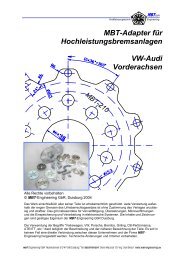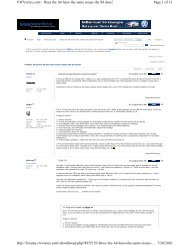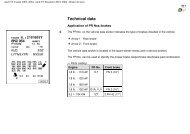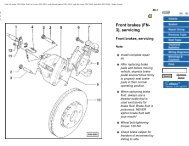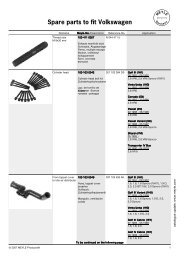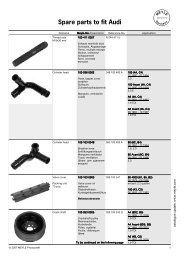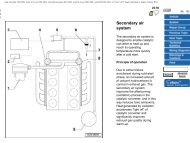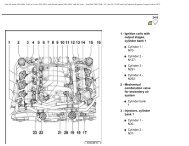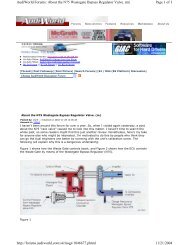VW MKII A2 MK2 Golf Jetta Fox Service Manual - VAGLinks.com
VW MKII A2 MK2 Golf Jetta Fox Service Manual - VAGLinks.com
VW MKII A2 MK2 Golf Jetta Fox Service Manual - VAGLinks.com
You also want an ePaper? Increase the reach of your titles
YUMPU automatically turns print PDFs into web optimized ePapers that Google loves.
3•8 Cooling, heating and air conditioning systems<br />
7.3 Cooling fan thermo-switch 7.11 Temperature sender unit thermoswitch<br />
location - 1.05 and 1.3 litre<br />
the joint. Clean off the old gasket.<br />
18 Remove the thermostat.<br />
19 The impeller housing and impeller<br />
<strong>com</strong>plete with bearings are serviced as one<br />
part. If coolant is leaking through the bearing,<br />
or the impeller is damaged, the <strong>com</strong>plete<br />
assembly must be renewed.<br />
20 Fit a new gasket using jointing <strong>com</strong>pound,<br />
then fit the two pump halves together and<br />
tighten the bolts evenly.<br />
21 Fit the thermostat.<br />
Refitting<br />
22 Refitting is a reversal of removal. Always<br />
fit a new O-ring.<br />
23 On <strong>com</strong>pletion, refill the cooling system.<br />
24 Correctly tension the drivebelt(s).<br />
7 Cooling system electrical<br />
switches - removal, testing<br />
and refitting<br />
Cooling fan motor thermoswitch<br />
2<br />
1 Disconnect the battery negative lead.<br />
2 Drain the cooling system.<br />
3 Unscrew the thermo-switch from the<br />
left-hand side of the radiator and remove the<br />
sealing ring (see illustration). Note that from<br />
September 1985, on fuel injection engines<br />
(except 16V) the switch, located in the bottom<br />
of the radiator, is of a 3-pin type, replacing the<br />
previous 2-pin type. The new switch has two<br />
operation temperature ranges, the first range<br />
operating the coolant fan at normal speed and<br />
the second range operating the fan at boost<br />
speed.<br />
4 To test the thermo-switch, suspend it with a<br />
piece of string so that its element is immersed<br />
in a container of water. Connect the<br />
thermo-switch in series with a 12 volt test<br />
lamp and battery. Gradually heat the water<br />
and note its temperature with a thermometer.<br />
The test lamp should light up at the specified<br />
switch-on temperature and go out at the<br />
specified switch-off temperature. If not, renew<br />
the thermo-switch.<br />
5 Refitting is a reversal of removal. Fit a new<br />
sealing ring and tighten the thermo-switch to<br />
the specified torque.<br />
6 On <strong>com</strong>pletion, refill the cooling system.<br />
Cooling fan temperature sensor<br />
7 From March 1986, the cooling fan is also<br />
controlled by a temperature sensor located<br />
between injectors 1 and 2. A time relay is also<br />
incorporated in the wiring circuit to keep the<br />
system functional for 10 to 12 minutes after<br />
switching off the ignition.<br />
Temperature sender<br />
unit/thermo-switches<br />
8 It is not necessary to drain the cooling<br />
system if some form of plug, such as an old<br />
sender unit or rubber plug, is available as a<br />
substitute for the removed switch.<br />
9 Release any pressure in the system by<br />
unscrewing the pressure cap. If the system is<br />
still hot, observe the precautions at the start<br />
of this Chapter. With all pressure released,<br />
retighten the cap.<br />
10 The location of the sender unit or<br />
thermo-switch is dependent on engine type.<br />
In general, they are as follows:<br />
1.05 and 1.3 litre engines<br />
11 The thermo-switch is located in the<br />
intermediate piece in the hoses between the<br />
inlet manifold and thermostat housing (see<br />
illustration).<br />
12 The temperature sensor is located in the<br />
thermostat housing (see illustration).<br />
1.6 and 1.8 litre carburettor engines<br />
13 The temperature sender unit is located in<br />
the heat exchanger hose connecting flange on<br />
the rear of the cylinder head.<br />
14 The thermo-switch (inlet manifold preheater)<br />
is located on the top face of the hose connector<br />
7.16 Temperature sender unit (A) and<br />
thermo-switch (B) - 1.8 litre, fuel injection<br />
1081 <strong>VW</strong> <strong>Golf</strong> & <strong>Jetta</strong><br />
7.12 Temperature sensor (arrowed) -<br />
1.05 and 1.3 litre<br />
on the spark plug side of the cylinder head.<br />
15 The thermo-switch (automatic choke) is<br />
located in the base of the hose connector on<br />
the spark plug side of the cylinder head.<br />
1.8 litre fuel injection engine<br />
16 The temperature sender unit is located in<br />
the hose connector on the spark plug side of<br />
the cylinder head (see illustration).<br />
17 The thermo-switch is located on the top<br />
face of the hose connector on the spark plug<br />
side of the cylinder head.<br />
1.8 litre 16V engine<br />
18 The temperature sender is located on the<br />
flywheel end of the cylinder block below the<br />
outlet elbow and controls the temperature<br />
gauge.<br />
All engines<br />
19 Disconnect the wiring lead from the<br />
sender unit/switch concerned.<br />
20 Unscrew and remove the sender<br />
unit/switch and plug the aperture.<br />
21 Refitting is the reversal of the removal<br />
procedure. Tighten the sender unit/thermoswitch<br />
to the specified torque.<br />
22 On <strong>com</strong>pletion, check and if necessary<br />
top-up the cooling system.<br />
8 Heater controls - removal<br />
and refitting 3<br />
Removal<br />
1 Disconnect the battery earth lead.<br />
2 The heater control unit is located in the<br />
centre of the dashboard. It is accessible after<br />
the radio has been removed or, on vehicles<br />
without a radio, the cubby hole.<br />
3 Pull off the control knobs and unclip the<br />
trim panel (see illustrations).<br />
4 Remove the three cross-head screws<br />
holding the control unit and ease it forward<br />
(see illustration).<br />
5 The cables can now be unhooked from the<br />
control unit levers and their outer body<br />
unclipped from the control unit body.<br />
6 If a cable is to be renewed, unhook it from<br />
the control flap at the other end and withdraw<br />
it. For access to the flap control valves, it is



